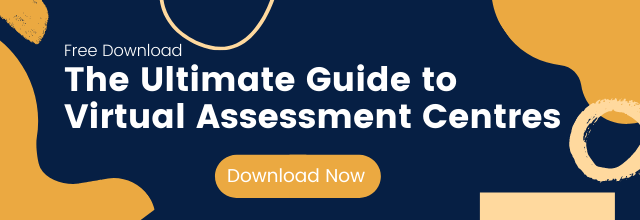Assessment Centres
Assessment Centres (ACs) have been a highly reliable process in many talent programmes however due to the high cost and time investment it has become un-scalable in many organisations. By leveraging on technology to virtualise the entire process, organisations can make talent decisions quicker, cheaper and more reliably.
In the spirit of overcoming MCO constraints amidst COVID-19, Accendo has recently conducted a virtual lunch and learn session to share about virtual assessment centres (VACs), covering topics including:
- History of ACs
- Benefits and Limitations
- Key Focus Areas for VACs
- Steps to VAC Deployment
- Key Learnings
Like the many technological and scientific advancements from during war times, Assessment Centres were first developed and adopted in the context of military officer selections, before AT&T adopted it in a corporate context. ACs has since evolved to the global practice that we do today.
Click here to download free Ultimate Guide to Virtual Assessment Centres.
So, why has Assessment Centres been adopted and utilised since the mid 1930s till now? There is plenty of research out there about its validity and predictability. ACs has several benefits that have made it an important global practice:
- It gives a realistic job preview to not only candidates/potential hires, but also to employers.
- Furthermore, ACs are designed in such that candidates are cross observed and evaluated by different assessors in various exercises against the same criteria, which gives the results an increased layer of rigor, validity and objectivity.
- With the war on talent today, employers are no longer only facing off against competitors, but also cross-industries and against start-ups. Hence, ACs provide employers with the avenue and opportunity to employ talent attraction strategies and improve employer branding.
However, there are also several limitations for the traditional Assessment Centre.
- Traditional ACs are logistically and resource heavy, in addition to the expertise required. Apart from the time and expertise needed to design and build the exercises, the planning and management of AC administration requires significant effort, e.g. training assessors, arranging location and accommodation.
- With the high level of complexity, resources, cost and expertise required, employers have to gain buy-in from stakeholders, especially in justifying the budget and ensuring commitment from multiple parties to the process and outcome.
- Furthermore, even though ACs can be used to assess almost any job, ACs are commonly used only for graduate trainee programmes and senior level positions due to resource and budget limitations, thereby reducing its scalability.

Key Focus in Virtualisation
To ensure companies get the full benefit of VACs and in turn make accurate talent decisions, there are a few key focus areas to virtualising a VAC:
- Reduce, Reuse & Replace
- Create the Right Candidate Experience
- Leverage on Data
Reduce, Reuse & Replace
As with the concept of recycling, this can be similarly applied to the resources used in ACs.
- Reduce: This is about re-evaluating what resources are really needed, and if needed, how can we do it more efficiently. E.g., the time and cost to run an AC would typically require 1-3 days, but a virtual administration would significantly cut down on time and material cost.
- Reusing: As 76% of organisations already utilise assessment tools*, they can be reused in VACs. Commonly used assessments like 360 feedback and newer ones like video interviews can be integrated for use within a VAC. Furthermore, the online branding that companies are already doing can be re-used and leveraged in the VAC.
- Replacing: Most traditional AC exercises are less scalable due to its limitations. In VACs, the virtual equivalent can be used to overcome these limitations, e.g. business simulations, virtual team simulations and pivotal experience interviews.
Create the Right Candidate Experience
Research from Mercer has indicated that 81% of HR teams are investing in tech specifically for candidate experience. VAC platforms are a catalyst to candidate experience and branding:
- Branding: VACs are one of the best tools to promote employer brand because the entire virtual experience a candidate goes through can be designed to match the employer brand the company wants to convey in a much more impactful way.
- Integration and consolidation: Oftentimes, companies face the issue of candidates having to re-do similar assessments or that the data does not speak to them. Through an integrated VAC platform, different assessments can be rolled out together, providing a smooth candidate journey and consolidating all data into a meaningful output.
- Candidate Functionality: Leveraging on technology, functionality and candidate user experience can be much enhanced and made a lot easier. For example, one-click access, completing assessments at own convenience, solutions to manage varying levels of internet connectivity and so on.
- Accessibility: Accessibility is important to achieve scalability, as it can influence important numbers such as completion rates. Understanding the demographics of the candidate pool will give a view on how accessible the platform needs to be, e.g. mobile compatibility. The more diverse the demographic, the more accessibility impacts the overall experience.
Leverage on Data
Technology is able to process large amounts of items and score it according to algorithms without subjective bias.
- Speed: VACs can be accomplished as a speedy process. On top of the logistical and time cost-cutting, VAC scoring and reporting outputs can be generated on the spot upon completion.
- Accuracy: The stacking of assessment tools increases its validity and accuracy, in addition to output data guiding the feedback and sharper interview processes.
- Holistic: One of the vital aspects about leveraging data points is the idea of collecting holistic information. With VACs, talents can be viewed holistically through multiple different facets.
- Scalability: With the technology and data, VACs can be conducted not only for limited job roles or levels, but throughout the organisation while tailored to expected competencies of different job roles.

Now with the key areas of VACs covered, we can look into a high-level overview of the steps in VAC deployment:
01 Planning
- Job Analysis: Evaluating the job accountabilities, job levels and needs of the jobs in future.
- Define Competencies: What does good look like? Understanding out what behaviours are expected of the job role.
- Exercise Mapping & Design: Understanding and simulating the environment/context for the job and mapping the appropriate assessment tools to measure the competencies.
- Candidate Experience: Crafting the communications, language used in the VAC, e.g. email invitations. Ensuring the right length and process of the VAC.
02 Execution
- Platform setup: Setting up the platform and the candidate journey.
- Define Competencies: Deciding the appropriate proficiency levels and behavioural indicators for defined competencies.
- Exercise Mapping & Design: Revisiting the assessment tools mapping and setting up the assessment tools to measure these competencies on the platform
- Candidate Experience: Testing and reviewing the candidate experience
03 Analysis
- Score Outcomes: Choosing the appropriate score output and which reports are needed.
- Cut-Off Scores: Whether there is an automated score cut-off and evaluating what this means to the assessment passing rate.
- Additional Data: Reviewing what extra information has been collected and which metadata to consider.
- Bias & Inconsistencies: Evaluating whether ratings were justified and ensuring consistency of candidates’ completion of assessments.

Key Takeaways and Learnings
Last but not least, the session was concluded with some key takeaways and learnings based on our experiences with VACs:
Design determines output: Always start with design first because the output will be sharper. Consider which competencies are key to the role and avoid over depending on one assessment tool to measure.
Candidate Experience vs Engagement: Think about the candidate experience, what are the high touch areas surrounding VAC, the interactivity of VAC exercises, as well as the timing (length, when to deploy etc) and messaging, e.g. the Why of VACs.
Think about your audience first: Think about who your candidates are, their job levels as well as the purpose of the AC (e.g. recruitment/development).
Security: As with any technology deployment, security is of high importance, as information is being collected from people and security/information leakage is best prevented.
Don’t Overload Because It’s Online: Avoid overloading because it is online or put in too many assessments just because they are 5 minutes each.
To wrap up, Assessment Centres have evolved and improved throughout the many years, leading us to where we are today – VACs. However, this is not where it ends, one day, VACs could potentially enhance further, transforming into new concepts such as a collaborative virtual career fair and AC. While an experimental concept now, it is a next step to the future of assessment centres.
References
* https://hbr.org/2015/07/ace-the-assessment
Page Contents







